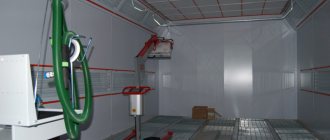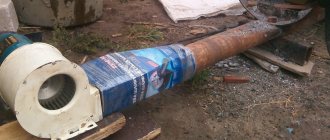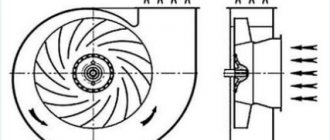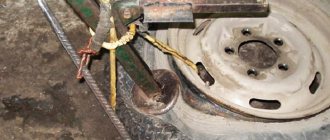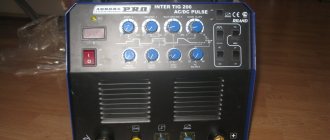Operating principle of a centrifugal fan
Inside the vacuum cleaner we see a picture:
- Air from the bag (tank, container), cleaned of dust, approaches the engine from the front and enters the center of the drum.
- The molecules, accelerated by the blades to a significant speed, are thrown out. They pass through the channels of the sealed housing, simultaneously cooling the engine, and leave the belly of the vacuum cleaner from the back side.
Design feature: the blades of a centrifugal fan create pressure; if the housing is leaky, the air flow will be disrupted. Therefore, the difficulty for a self-taught master is to create the right conditions.
Good hoods use motors with tangential (centrifugal) type fans. In selected designs, the design surprises with a duet of squirrel cages. In the latter case, a pair of impellers is mounted on either side of the engine on a shaft. Then the air enters from two directions perpendicular to the plane of rotation of the wheels. Thus, the efficiency of the centrifugal fan increases.
Operating restrictions
Despite the strength and reliability of industrial snails, there are some restrictions on their use. So, centrifugal fans, commonly called “snails”, are not recommended to be installed if:
- There are suspensions in the air with a sticky consistency of more than 10 mg/cubic meter.
- There are particles of explosive substances in the room.
- The room temperature is outside the range of -40 to +45°C.
Moreover, it is rational to use snail ventilation in large rooms; in everyday life, it is better to install such devices in ventilation shafts, where all the exhaust air from the house enters.
Design and operating principle
Fan devices used to move various mixtures of gases and air come in several types. The most popular is the centrifugal radial “snail” unit.
It has a rotating wheel assembly and blades attached to it. Different fan models contain different numbers of blades.
The operating principle of the snail hood is as follows:
- Air is sucked into the rotor through the inlet;
- The air mass receives rotational motion;
- Next, by means of the centrifugal force created by the rotating blades, air under pressure is forced to the outlet. It is located in a spiral casing.
Due to the resemblance of the casing to a snail, the fan got its name.
Housing materials
An industrial “snail” can include different materials, depending on the aggressiveness of the application environment. Sheathing of a general-purpose unit operated in non-aggressive gas mixtures with a particle content of less than 0.1 g/cubic meter. m, made from galvanized or carbon steel sheets of different thicknesses. If the environment contains aggressive gas mixtures, is characterized by the presence of active gases and the evaporation of acids, corrosion-resistant steels are used. This type of snail fan operates at temperatures up to 200 degrees Celsius.
There is an explosion-proof version of the hood housing. It is assembled from ductile metals: copper or aluminum alloys. Here, during operation of the hood, sparking, which is the main cause of explosions, is eliminated.
Working wheel
The material requirements for the impeller with blades are plasticity and corrosion resistance. Then the wheel will withstand vibration loads and chemical influences of the environment
To design the shape and number of blades, aerodynamic loads and rotation speed are taken into account. High rotation speed of a large number of slightly curved or straight blades creates a stable air flow
This creates less noise.
Centrifugal exhaust should be classified as equipment with increased vibration. The cause of vibration is the low level of balance of the rotating wheel. Vibration carries with it the following negative factors: destruction of the foundation at the installation site of the equipment and high noise levels. The installation of shock-absorbing springs minimizes vibration. The springs are mounted under the base of the housing. In addition, some models use rubber cushions instead of springs.
Electric motors
Snail-type ventilation equipment is equipped with electric motors with explosion-proof covers and housings. A special protective compound is used to paint engine housings. For the most part, these are asynchronous mechanisms with a fixed rotation speed. They are connected to a single-phase or three-phase network, depending on the design. In special cases, variable speed motors are used.
Dimensions
The sizes of snail hoods can be different. The diameter of the unit varies from 250 to 1500 mm. “Snails” can represent a single whole or be divided into several parts. In the case of small fans with a solid volute, the rotation angle can be neglected. Simply unscrew the bolts and rotate it to the desired position. Larger models are mostly collapsible. For them, the rotation angle is an important parameter that should be taken into account.
Ventilation of industrial premises is a necessity that helps preserve the health of workers and ensure uninterrupted operation of the workshop. To clean the air from various impurities, metal and wood shavings, dust and dirt, powerful “snail” ventilation units are most often used. The design of these units includes several fans of different power, and therefore the “snail” can cope with almost any contaminant.
Kinds
The scale of the premises, as well as the level of pollution and heating of the air in them, require the installation of exhaust systems of the appropriate size, power and configuration. Therefore, centrifugal fans come in different types.
Depending on the level of pressure created by the air masses in the exhaust duct, they are classified into fans:
- Low pressure – up to 1 kPa. Most often, their design provides for wide sheet blades that are bent forward to the suction pipe, with a maximum rotation speed of up to 50 m/s. Their scope of application is mainly ventilation systems. They create less noise, so they can be used in rooms where people are constantly present.
- Medium pressure. In this case, the level of load created by the movement of air masses in the exhaust duct can be in the range from 1 to 3 kPa. Their blades can have different angles and tilt directions (both forward and backward), and can withstand a maximum speed of up to 80 m/s. The scope of application is wider than that of low-pressure fans: they can also be installed in process plants.
- High pressure. This technique is used primarily for process plants. The total pressure in the exhaust duct is from 3 kPa. The power of the installation creates a peripheral speed of the suction masses of more than 80 m/s. Turbine wheels are equipped exclusively with backward-curved blades.
Pressure is not the only sign by which radial fans are distinguished. Depending on the speed of the air masses, which is provided by the impeller, they are divided into two classes:
- Class I - indicates that frontally curved blades provide a speed of less than 30 m/s, and back-curved blades provide a speed of no more than 50 m/s;
- Class II includes more powerful units: they provide speed to the driven air masses higher than Class I fans.
In addition, the devices are manufactured with different directions of rotation relative to the suction pipe:
- those oriented to the right can be installed by turning the housing clockwise;
- to the left - counterclockwise.
The scope of application of snails largely depends on the electric motor: its power and the method of attachment to the impeller:
- it can gain speed directly on the engine shaft;
- its shaft is connected to the engine using a coupling and fixed by one or two bearings;
- using a V-belt drive, provided it is fixed by one or two bearings.
How to make it yourself
One of the features of such snails is their different price range. The minimum price for a snail hood will be about 3 thousand, but such devices, as a rule, are not very powerful and are very limited in size. The average price of a high-quality unit will exceed 20 thousand rubles.
Therefore, for domestic needs, it is more advisable to make a homemade snail for extractor hood. The standard design of such a housing will consist of two parts: the engine will be located in one zone, and the blowing blades in the other.
The casing for the snail can be purchased at hardware stores. If you are going to make it yourself, purchase the motor and other parts in advance, since the dimensions will have to be adjusted. It is better to make the case from metals (for example, aluminum and steel). Plastic will be less resistant to mechanical damage, and wood will quickly catch fire in the event of a malfunction.
The fan in such a system will operate at high speed. Therefore, incorrect design of the hood can have bad consequences. Check the quality and reliability of not only the base itself and fastening mechanisms, but also the motor, impeller and fan.
The fan dimensions are selected taking into account the area and degree of contamination of the room. Industrial designs are large.
Important! When installing the motor inside the box of such a hood, make sure that the design includes cooling holes. High temperature stress on the system may cause an explosion
Pay special attention to the choice of internal materials. Fan operation can be affected not only by temperature, but also by the power of air flow, the amount of debris and dust.
When air with large impurities is sucked in, the blades of the rotating wheel may be damaged. And in order to thoroughly clean the air, the unit must operate at high speed and under high pressure - this creates additional stress on the entire internal structure. Therefore, it is better to choose parts made of durable materials, such as steel or aluminum
.
- choose the right size and power of the motor
: take into account the maximum load on the structure, as well as the required operating speed of the hood; - When mounting such a system vertically, carefully check the reliability of the fan and wheel fastening
: with rapid air flows, they can jump off or change their location; - materials adjacent to such a hood must be fireproof
, as are all parts used in its assembly; - observe the proportions between the individual hood zones
: in the standard models offered in stores, the optimal ratio of the length and width of the structure is taken into account; - If you are not sure that the assembled hood is safe, contact specialists who will check its serviceability
.
Please note that snail hoods are rarely used in living rooms. Firstly, they take up a lot of space, and secondly, in rooms like a kitchen, flows of polluted air can have different directions, so it is best to install such a hood in a ventilation shaft, where all the air coming from the apartment is concentrated
The design of such structures will also play an important role in living rooms, but it is not diverse and does not always harmonize with the interior.
Advice:
When placing such a hood in open conditions (outdoors), make sure that weather conditions will not affect its functionality.
Ventilation hoods can be used not only for air purification
.
In domestic conditions, they will do an excellent job of heating the room, and will also affect the humidity in the room
.
The cost of equipment intended for domestic and industrial needs will differ significantly, but, in any case, such units have sufficient power for full operation.
For an example of designing a snail hood, see the attached video.
Creating high-density airflow is possible in several ways. One of the effective ones is a radial type fan or “snail”. It differs from others not only in shape, but also in its operating principle.
Approximate cost of a ventilation system (design + equipment + installation)
Let's calculate the cost when arranging a room for painting:
| Expenditure | Cost, thousand rubles |
| Design taking into account lighting, ventilation, heating, filters | From 50-70 |
| Scroll fan in explosion-proof design, 18000 m³/h, 4 kW | 40 (we need 2 pieces, that means 80) |
| Heater (diesel or gas) 250 kW | From 75 |
| Air temperature sensor | 1 |
| Floor filter for paint retention (PS3), roll 0.75x20 m | 5 |
| Ceiling fine filter, class F5, roll 2x20 m | 15 |
| Carbon filter (for exhaust) | 12-15 |
| Differential pressure gauge (to monitor filter contamination) | 3-4 |
| A set of galvanized air ducts (with all bends, adapters, inserts), 30-40 m long (for supply and exhaust, with a reserve) | 75 |
| Ventilation control panel | 5-15 |
In total, it comes out to about 320 thousand rubles only for ventilation (that is, lighting, wall decoration, floor grilles, entry, gates - we pay separately). This does not include the services of specialists in installing and connecting this equipment. Of course, we calculated roughly rounded amounts, and in practice the price may be lower.
Approximate cost of a finished chamber with a ventilation system
Ready-made spray booths with ventilation (for 1 passenger car) cost approximately the following:
- Colortech CT 7000 (Türkiye): from 1.3 million rubles. Size - 7x4x2.8 m, burner 237 kW, supply and exhaust capacity - 18,000 m³/h.
- Colortech CT 6000 (Turkey): from 1.1 million. The characteristics are the same, only the size is different: 6.2x4.08x3.4 m.
- SK-1 Technosoyuz (RF): from 750 thousand. Size - 7.2x4.8x3.5 m, air capacity - 22000 m³/h, temperature control - from +20º to +90º.
- Guangli GL-2000A GL-3 (China): from 1 million. Size - 6.9x3.9x2.7 m, air capacity - 24,000 m³/h.
- Technoline Grand (China): from 800 thousand. Size - 6.9x4x2.9 m, air exchange - 26000 m³/h, 330 kW diesel burner.
- SPK-4.4.3 (RF): from 2.7 million. Size - 4x4x3 m, air exchange - 10,000 m³/h, for air heating - 282 kW heating element. There is a programmable controller with touch control.
- Atis Aqua Prima 7.5.4 (RF): from 900 thousand. Size - 6.9x3.9x2.7 m, air exchange - 24000 m³/h, diesel burner 218 kW.
- Nordberg Standard (China): from 975 thousand. Size - 6.9x3.9x2.7 m, air exchange - 80,000 m³/h, 202 kW diesel burner.
All models have filters (the set and their quality varies), built-in explosion-proof lamps, fire sensors, and ventilation control systems. The price does not include delivery and installation.
It turns out that for a conventional 1 million rubles you can get a ready-made chamber with ventilation, lighting, heating and filters. If you look at the cheapest models, or look for used ones, you can find equipment for 500-600 thousand.
Therefore, it is easier and faster to take a ready-made camera than to equip it from scratch. In terms of price, it will cost a little more or about the same as the arrangement. But in the end, you get a completely finished box that will allow you to correctly apply the painting technology, will not pollute the air with harmful emissions, and will not create a danger for the painter.
Presentation of the Blowtherm spray booth (video, not in Russian)
Do it yourself
Building a scroll fan is not the most difficult thing if you decide to take on a homemade unit with your own hands.
- Functional purpose. To equip a part of a room, a small area or equipment with a ventilation system, the housing can be assembled from scrap materials. If this is a centrifugal unit that will generate air flows to ensure the operation of boiler equipment, then the housing is made by hand using stainless steel or heat-resistant metal.
- Power. This parameter directly depends on the functions that the centrifugal unit will perform. Many home craftsmen use snails removed from old equipment, ventilation systems, hoods or vacuum cleaners. By using such a unit, you guarantee an exact balance between power and body characteristics.
If you want to make a snail for domestic use or for use inside a workshop, then you can assemble the device yourself. All other situations imply the need to use only factory-proven, proven snails.
To assemble an effective homemade snail fan with your own hands, you will need to complete the following tasks:
- Calculate the dimensions of future equipment. If this is a centrifugal unit for installation in a confined space, be sure to use damper pads. They will compensate for the vibrations generated during its operation and protect the volute from premature wear. If this is a large stationary unit, vibration protection occurs due to the weight of the equipment and its fixation;
- Make a fan casing. If you do not have a ready-made box that is ideal for the fan, use scrap materials. Plastic, plywood sheets, and steel are suitable for these purposes. If you decide to take sheets of plywood, make sure that during the process of assembling the structure there are absolutely no gaps and all seams are properly sealed;
- Think over the diagram of the snail's power unit. The job of the power plant is to rotate the fan blades. When choosing, consider how much power the snail has. If it is a high power centrifugal fan, use a belt drive. In small installations, it is important to use a shaft that connects the motor gearbox to the rotor;
- Use fasteners. When installing a scroll fan on the outer casing of the structure, U-shaped mounting plates are used. If the power of the units is impressive, then be sure to adopt a massive, durable base;
- Minimize noise. A high-power volute is characterized by the fact that such a centrifugal fan emits quite a lot of noise. Objectively, the best way to protect yourself from snail noise is to assemble the equipment with the highest quality possible. After assembling the cochlea, it is problematic to compensate for the noise. The noisiest models are those whose body is made of plastic and metal. Wooden cases reduce snail noise, but are significantly inferior to their metal and plastic counterparts in terms of service life.
According to the presented diagram, you can create centrifugal exhaust devices of various power purposes with your own hands. If necessary, you can make changes to the circuit, change components, add auxiliary elements.
The most significant point when assembling a fan with your own hands is the reliable sealing of all seams in the structure and the protection of the engine itself. Over time and with use, an engine that does not have proper protection can become exposed to various debris, dust, dirt and moisture. It is no secret that this leads to wear, gradual destruction and failure of equipment.
A low-power centrifugal fan will be of little use. Even quiet hoods are equipped with commutator motors that make a lot of noise. If the fact doesn’t frighten you, let’s proceed to choosing funds. We'll show you how to make a centrifugal fan with your own hands from scrap items. If in a typical axial fan the motor and impeller are important, here, in addition to everything else, the housing is added. Let's try to assemble a centrifugal fan ourselves.
Creation
Instructions for creation.
- Calculate the parameters and dimensions of future equipment. In this case, damper pads are inserted to avoid vibration during operation. These measures will help save the snail.
- Use of available materials in the manufacture of a fan housing made of plastic or plywood. When performing assembly work, make sure once again that there are no gaps and the seams are sealed.
- First you need to analyze the power circuits of the unit. Power is taken into account here. For high fan power, a belt drive is used. At low powers, a shaft and rotor-gearbox connections are used.
- Fastening elements are used, namely plates with the letter “P” for mounting on the body. A strong foundation is needed for powerful units.
Do it yourself
Building a scroll fan is not the most difficult thing if you decide to take on a homemade unit with your own hands.
There are several important recommendations that you should consider before building your own snail fan.
- Functional purpose. To equip a part of a room, a small area or equipment with a ventilation system, the housing can be assembled from scrap materials. If this is a centrifugal unit that will generate air flows to ensure the operation of boiler equipment, then the housing is made by hand using stainless steel or heat-resistant metal.
- Power. This parameter directly depends on the functions that the centrifugal unit will perform. Many home craftsmen use snails removed from old equipment, ventilation systems, hoods or vacuum cleaners. By using such a unit, you guarantee an exact balance between power and body characteristics.
If you want to make a snail for domestic use or for use inside a workshop, then you can assemble the device yourself. All other situations imply the need to use only factory-proven, proven snails.
To assemble an effective homemade snail fan with your own hands, you will need to complete the following tasks:
- Calculate the dimensions of future equipment. If this is a centrifugal unit for installation in a confined space, be sure to use damper pads. They will compensate for the vibrations generated during its operation and protect the volute from premature wear. If this is a large stationary unit, vibration protection occurs due to the weight of the equipment and its fixation;
- Make a fan casing. If you do not have a ready-made box that is ideal for the fan, use scrap materials. Plastic, plywood sheets, and steel are suitable for these purposes. If you decide to take sheets of plywood, make sure that during the process of assembling the structure there are absolutely no gaps and all seams are properly sealed;
- Think over the diagram of the snail's power unit. The job of the power plant is to rotate the fan blades. When choosing, consider how much power the snail has. If it is a high power centrifugal fan, use a belt drive. In small installations, it is important to use a shaft that connects the motor gearbox to the rotor;
- Use fasteners. When installing a scroll fan on the outer casing of the structure, U-shaped mounting plates are used. If the power of the units is impressive, then be sure to adopt a massive, durable base;
- Minimize noise. A high-power volute is characterized by the fact that such a centrifugal fan emits quite a lot of noise. Objectively, the best way to protect yourself from snail noise is to assemble the equipment with the highest quality possible. After assembling the cochlea, it is problematic to compensate for the noise. The noisiest models are those whose body is made of plastic and metal. Wooden cases reduce snail noise, but are significantly inferior to their metal and plastic counterparts in terms of service life.
According to the presented diagram, you can create centrifugal exhaust devices of various power purposes with your own hands. If necessary, you can make changes to the circuit, change components, add auxiliary elements.
The most significant point when assembling a fan with your own hands is the reliable sealing of all seams in the structure and the protection of the engine itself. Over time and with use, an engine that does not have proper protection can become exposed to various debris, dust, dirt and moisture. It is no secret that this leads to wear, gradual destruction and failure of equipment.
The mechanism of any fan is based on a rotor with blades attached to it. Their purpose is to move large masses of air for the purpose of air circulation.
The scope of application of centrifugal fans "snail" is very wide. They are used in engineering systems of buildings, industrial ventilation systems, drying chambers, household appliances, painting, and blowing machines.
Popular models
In principle, there is no model division of snails. There are certain brands that are produced by all manufacturers. And they are divided mainly according to their intended purpose. For example, a VRP fan, where the letter “P” means that this is a dust model, which is used in ventilation and aspiration systems to remove air with a high concentration of dust. That is, this is a specific model that must be used for its intended purpose. Of course, this device can easily handle ordinary air, but it is more expensive than standard VR or VC, because its design uses thick metal to make the body and blades, hence the higher power of the electric motor.
The same applies to VR DU brand fans, that is, for smoke removal. They are made from higher quality materials with the installation of an explosion-proof motor. Hence their high price. As for other positions, VR is divided into types that have already been mentioned, and each group has its own models with its own technical characteristics.
Peculiarities
A good-quality snail fan can be obtained with your own hands during the assembly process only if you know the design. The installation and impeller create torque for air movement. The need for an exhaust device increases when space is limited, so installation takes place with specialized equipment. The fan casing is made in the form of a spiral and serves to direct air.
Homemade fans of this type have become very popular lately. However, if you lack the skills and the necessary time, purchasing ready-made equipment will be one of the best options.
To create an air flow in the inner part of the snail fan mount, you need to place a radial element - a wheel attached to the installation. The discharged space is created by the curved working blades of the wheel.
The air mass enters through the inlet pipe. The inlet pressure drops and draws in ambient air. As a result of the rapid movement of air in a spiral, the speed in the outlet hole increases significantly and high pressure is created. Air flows rapidly from the outlet pipe. If the pipe is on the left, then the rotor rotates clockwise, if on the right, then in the opposite direction.
When assembling with your own hands, the curvature of the “snail” blades used is taken into account.
Filters
These devices are very important components of the ventilation system, since the quality of the air both entering and exiting the paint booth depends on them. For the premises in question, several types of filters are used, but hoods for paint booths are usually equipped with cardboard filters.
These devices very effectively purify the air removed from the room due to the fact that varnish dust hardens in them. In addition, cardboard filters are easy to use, as they have a long service life, and their installation and disposal are easy to do yourself. The cost of the considered devices is 4000-5000 rubles.
The operation of exhaust filters is complicated by the fact that over time they become clogged with paint, varnish and dust. As a result, the speed of air passage through them is reduced, and, accordingly, the mode of its circulation in the paint booth is disrupted, resulting in the formation of paint and varnish suspensions.
Self-production
Let's consider how you can create a snail fan with your own hands, the drawings of which can be found on the Internet or made yourself.
Working wheel
First of all, you need to get an impeller
This is important because it is a fairly massive element and requires good balancing. If the impeller beats even a little, the bearings of the electric motor (or its own drive shaft) will quickly fail
Ready-made impellers from fans or air conditioners are often used, but if you can’t find them, you’ll have to make them yourself.
Landing sleeve
First of all, you need to make a landing coupling. It is made on a lathe. The coupling is then attached to the sheet metal by welding or screws, clamped in a lathe and carefully centered. The result is a round disk with a seating sleeve in the center. Markings are made on it and the blades are attached. Making a drum-type impeller with your own hands is impractical, since high-quality balancing of homemade elements is impossible.
Frame
For the body, sheet steel or, as in the example in the video, wood is used. A strip 0.5-1 cm wider than the thickness of the impeller is cut out of it. The strip is bent, giving it the shape of a snail. This is the side of the body. Then two identical parts are made, repeating the profile of the side element.
One of the parts will become the outer side of the housing; a suction hole is made on it and a flange is secured for mounting air ducts or grilles. The second part is attached to the motor housing and has a hole for the passage of its shaft. It is secured to the engine with bolts, the side curved part is welded to it with a continuous seam without gaps. Bolts are welded to the edge, which will press the outer part with the suction hole.
Assembly
In addition, all homemade products make a lot of noise during operation, and it is extremely rare to get rid of this. It is pointless to take on manufacturing without having plumbing skills, the ability to weld sheet steel with high quality and perform other work. The price of a finished fan is not so high that it wastes time, materials and equipment.
General requirements for the ventilation system of a paint booth
Let's list the main rules:
- Ventilation should be only mechanical (forced).
- Filters must be installed on both the supply and exhaust.
- Ventilation equipment must be explosion-proof.
- Air is supplied through the ceiling, flowing vertically downwards. Exhaust hood - organized through floor gratings.
What is taken into account when designing? (+video with general information)
That's what:
- Car size. The size of the chamber itself depends on this - it should not be too large, since then a more powerful ventilation system will have to be made. The average size of cameras for passenger cars is 6.9x3.9x2.7.
- Type of paint (to know the composition of paintwork materials, type of solvents). Based on this, better filters can be selected.
- How often do you plan to paint, and how long will the work take?
Peculiarities
The main feature of a scroll fan is its ability to create high outlet pressure
. Axial structures have high performance, but most of them are not capable of creating pressure. Therefore, only “snails” are suitable for working with a complex air duct system with high aerodynamic resistance.
Based on the amount of pressure created, they are divided into three categories:
create a vacuum to work both for discharge and suction
additional functions
transport bulk materials through the air duct system
The most popular models of “snail” fans are VR and VTs
(
Radial Fan
and
Centrifugal Fan
). Some complication of the situation in this regard is that there are no special rules for naming fans and each manufacturer has the right to name their products as they see fit. Therefore, models of “snail” fans often appear that have exactly the same parameters, but different designations.
Unity of standard sizes is necessary for the possibility of connection to other equipment -, etc. In this regard, the situation is more successful; the fans fit completely into adjacent elements of the system. If models and elements of different standard sizes are used, then appropriate adapters are used to pair them.
Description of calculations of blower machine parameters
The calculation of any type of ventilation unit is carried out according to individual aerodynamic characteristics, and an axial fan is no exception. These are the characteristics:
- Volume flow or productivity.
- Efficiency.
- The power required to drive the unit.
- The actual pressure developed by the unit.
The performance was determined earlier when the ventilation system itself was calculated. The fan must provide it, so the air flow value remains unchanged for calculation. If the air temperature in the working area differs from the temperature of the air passing through the fan, then the performance should be recalculated using the formula:
L = Ln x (273 + t) / (273 + tr), where:
- Ln — required productivity, m³/h;
- t is the temperature of the air passing through the fan, °C;
- tr is the air temperature in the working area of the room, °C.
Return to contents
Mechanical ventilation
Types of ventilation
Ventilation tree
- As you can see in the top image, the word “ventilation” can mean completely different methods of air exchange and some you may not have even heard of, but we will briefly consider only the most basic of them.
- Firstly, there is a well-known exhaust method, when warm or polluted air is removed from the room.
- Secondly, there is a supply option and most often this is the addition of fresh cool air.
- Thirdly, this is a combination, that is, a supply and exhaust option.
- The above systems can function naturally, but can also be forced using axial (axial), radial (centrifugal), diametrical (tangential) and diagonal fans. In addition, exhaust and air supply can be carried out either in general or in local mode. That is, the air duct is supplied to a specific destination and performs the function of blowing or exhaust.
Cochlea wiring
After all the elements are prepared, all that remains is to install the entire system.
Step-by-step instructions for laying a snail floor:
- Make a concrete screed. Attach reinforcement and a heat-insulating layer or special rubber mats with bosses to the floor, which serve as fasteners.
- Laying the circuit must begin from a heat source. The contour is laid from the large perimeter to the center. The step between the elements with a double snail doubles, since the pipes will then go back.
- When laying, the heater is immediately fixed using special fasteners to the fittings or substrate.
- A 180 degree turn is made in the center. The coolant is laid back in a spiral.
- The pipes return to their original exit point - to the collector or distributor.
- Before pouring the floor and installing the decorative covering, the system is tested.
Advice. When laying the contour, you must first make chalk markings. This will significantly speed up and facilitate the process.
